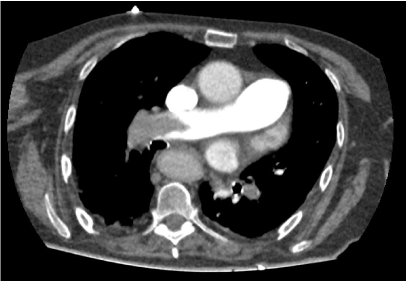Introduction
High Flow Nasal Cannula (HFNC) oxygen therapy is a recent technique that delivers a high flow of heated and humidified gas to the patient [1]. Compared to noninvasive ventilation (NIV), HFNC has been proved to be an effective alternative treatment for acute respiratory failure. HFNC also has a significant number of physiological advantages compared with other commonly used oxygen-based therapies, including PEEP, reduced anatomical dead space, constant FiO2 and it is better tolerated than NIV [2]. After a thorough bibliographical research, only one article was found assessing the benefits of using HFNC in patients with acute pulmonary embolism [3]. We present the case of an 86-year-old patient with acute pulmonary embolism and desaturation refractory to noninvasive ventilation.
Case report
An 86-year-old woman who suffers from a poorly controlled permanent atrial fibrillation treated with Rivaroxaban. On June 2018, the patient presented to the Emergency Department referring a sudden onset dyspnea and agitation, without chest pain or syncope. The patient has a history of severe pulmonary embolism in 2004. Despite being anticoagulated with Rivaroxaban, the adherence to treatment was not optimal and the patient had not complied with it for 4 days prior to her admission into the Emergency ward.
At her arrival, she presented tachycardia (120 beats per minute), normal blood pressure (132/90 mmHg) and the hemoglobin saturation of oxygen was 76%. When it came to physical examination, the patient has normal breath sounds, signs of chronic venous deficiency but no clinical data suggestive of deep vein thrombosis. The laboratory results showed troponin: 0.3 ng/mL; brain natriuretic peptide: 1336 pg/mL; leucocytes: 14000 with neutrophilia; creatinine: 1.58. Arterial gasometry revealed pH: 7.41; pCO2: 31.0 mmHg; pO2: 34.0 mmHg; HCO3-: 17.9 mM/L.
Wells score indicated a high probability of pulmonary embolism, hence anticoagulation with low molecular weight heparin at therapeutic dose was initiated. CT pulmonary angiography revealed filling defects affecting the right main pulmonary artery, right lobar and segmental arteries, left lobar artery and lingular artery, all these findings being compatible with acute pulmonary embolism (Figure 1). Diuretic treatment with Furosemide was optimized and despite all the measures, the dyspnea persisted, and oxygen saturation was still low. Therefore, noninvasive ventilation was started. After one hour of therapy, the oxygen saturation values were around 83%, so NIV was substituted by HFNC, reaching a SatO2 of 94% in the following minutes.

Figure 1. CT pulmonary angiography showing acute pulmonary embolism
The patient remained clinically stable during the following days, allowing a progressive reduction of the flow. After 5 days in the Pneumology ward, weaning of HFNC was possible, maintaining good oxygen saturation values and hospital discharge was decided.
Discussion
HFNC has several advantages such as providing higher flow rates, which creates a positive pressure effect and reduces the anatomic dead space; delivering a predictable and constant FiO2 [4]; increasing the partial arterial pressure of oxygen (PaO2)/FIO2 ratio, which reduces the entrainment of room air and the dilution of oxygen; providing heated and humidified gas that is inhaled and can improve mucociliary motion and sputum clearance; reducing upper airway resistance and work of breathing; and improving thoraco-abdominal synchrony. Based on the above advantages, several studies found that HFNC could improve comfort level, increase oxygenation and decrease the dyspnea score in adult patients
Even though superiority is still being studied seems that High-flow nasal cannula oxygen therapy (HFNC) is superior to noninvasive ventilation (NIV) and conventional oxygen therapy in hypoxemic patients in terms of mortality and avoidance of intubation [5]. Noninvasive ventilation in pulmonary embolism increases intrathoracic pressure, which may result in a decrease of right stroke volume and arterial pressure, and this is contrary to therapy objectives in PE.
Only a few cases of pulmonary embolism treated with HFNC have been reported. Messika et al analyzed 17 patients with severe PE (determined by profound desaturation under room air, SpO2 85% [70-89]) and HFNC administration for acute respiratory failure (defined by the need for at least 6 l/min of oxygen to achieve SpO2>92%), concluding that respiratory parameters significantly improved after to 2 hours of therapy with HFNC: SpO2 increased from 93% to 100%, respiratory rate decreased from 29 to 20 cycles/min and hemodynamic parameters did not show significant variations after the initiation of HFNC [3].
Therefore, this clinical report supports the previous published data, suggesting that HFNC is an effective therapy for patients with desaturation during the acute phase of pulmonary embolism. However, the authors emphasize the need for more randomized clinical trials to assess the effectiveness of HFNC in this type of patients.
References
- Frat JP, Coudroy R (2017) High-flow nasal oxygen therapy and non-invasive ventilation in the management of acute hypoxemic respiratory failure. Ann Transl Med 5: 297. [Crossref]
- Nishimura M (2016) High-Flow Nasal Cannula Oxygen Therapy in Adults: Physiological Benefits, Indication, Clinical Benefits, and Adverse Effects. Respiratory Care 61: 529-541.
- Messika J, Goutorbe P, Hajage D, Ricard JD (2017) Severe pulmonary embolism managed with high-flow nasal cannula oxygen therapy. Eur J Emerg Med 24: 230-232. [Crossref]
- Nishimura M (2015) 2021 Copyright OAT. All rights reservy in adults. J Intensive Care 3: 15. [Crossref]
- Zhao H, Wang H, Sun F, Lyu S, An Y (2017) High-flow nasal cannula oxygen therapy is superior to conventional oxygen therapy but not to non-invasive mechanical ventilation on intubation rate: a systematic review and meta-analysis. Critical Care 21:184

